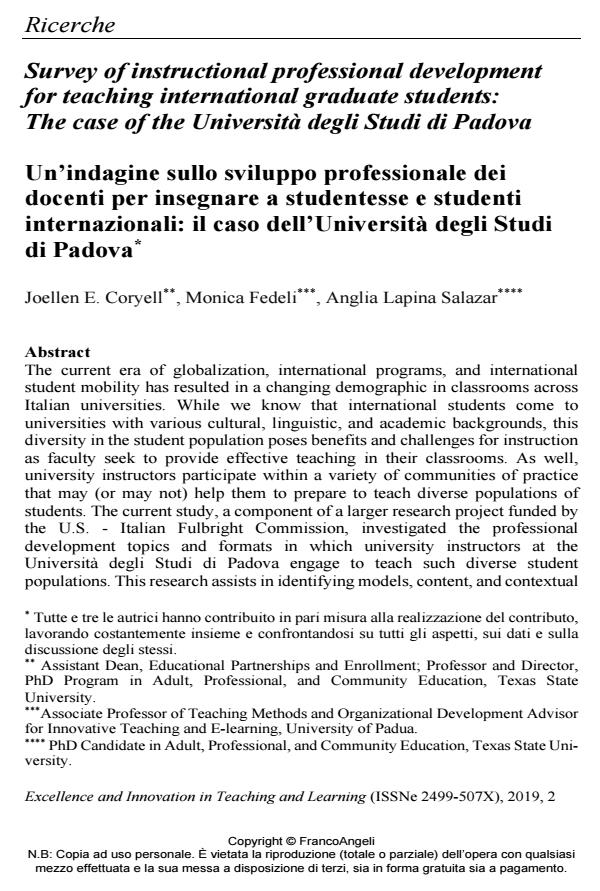Survey of instructional professional development for teaching international graduate students: The case of the Università degli Studi di Padova
Titolo Rivista EXCELLENCE AND INNOVATION IN LEARNING AND TEACHING
Autori/Curatori Joellen E. Coryell, Monica Fedeli, Anglia Lapina Salazar
Anno di pubblicazione 2019 Fascicolo 2019/2
Lingua Inglese Numero pagine 20 P. 22-41 Dimensione file 323 KB
DOI 10.3280/EXI2019-002002
Il DOI è il codice a barre della proprietà intellettuale: per saperne di più
clicca qui
Qui sotto puoi vedere in anteprima la prima pagina di questo articolo.
Se questo articolo ti interessa, lo puoi acquistare (e scaricare in formato pdf) seguendo le facili indicazioni per acquistare il download credit. Acquista Download Credits per scaricare questo Articolo in formato PDF

FrancoAngeli è membro della Publishers International Linking Association, Inc (PILA)associazione indipendente e non profit per facilitare (attraverso i servizi tecnologici implementati da CrossRef.org) l’accesso degli studiosi ai contenuti digitali nelle pubblicazioni professionali e scientifiche
The current era of globalization, international programs, and international student mobility has resulted in a changing demographic in classrooms across Italian universities. While we know that international students come to universities with various cultural, linguistic, and academic backgrounds, this diversity in the student population poses benefits and challenges for instruction as faculty seek to provide effective teaching in their classrooms. As well, university instructors participate within a variety of communities of practice that may (or may not) help them to prepare to teach diverse populations of students. The current study, a component of a larger research project funded by the U.S. - Italian Fulbright Commission, investigated the professional development topics and formats in which university instructors at the Università degli Studi di Padova engage to teach such diverse student populations. This research assists in identifying models, content, and contextual factors of informal and formal faculty development currently in Italy. The findings offer culturally nuanced insights for instructor professional development during a period of internationalization efforts and increased international student mobility.
L’attuale era di globalizzazione, l’offerta di corsi di studio internazionali e la stessa mobilità delle studentesse e degli studenti hanno creato un significativo cambiamento demografico nelle aule delle università italiane. Sappiamo che le studentesse e gli studenti internazionali hanno vari background culturali, linguistici e accademici, questa diversità nella popolazione studentesca pone vantaggi e sfide per l’istruzione e per i docenti che cercano di offrire una didattica efficace nelle aule universitarie. Gli stessi docenti fanno parte di diverse comunità di pratica che possono (o meno) sostenerli a prepararsi nell’insegnamento a diverse popolazioni di studentesse e studenti. La presente ricerca fa parte di un più ampio progetto finanziato dagli Stati Uniti - Commissione Italiana Fulbright, e affronta il tema dello sviluppo professionale dei docenti presso l’Università di Padova e come gli stessi affrontano l’insegnamento con popolazioni studentesche così diverse. Questa ricerca affronta i temi che riguardano i modelli, i contenuti e i fattori di contesto dello sviluppo professionale del docente universitario a livello formale e informale in Italia. I risultati offrono approfondimenti culturalmente sfumati per la formazione e lo sviluppo in un periodo di forte spinta verso l’internazionalizzazione e la mobilità studentesca.
Parole chiave:Internazionalizzazione in higher education, insegnare in higher education; insegnare in contesti internazionali, faculty development, instructional development.
Joellen E. Coryell, Monica Fedeli, Anglia Lapina Salazar, Survey of instructional professional development for teaching international graduate students: The case of the Università degli Studi di Padova in "EXCELLENCE AND INNOVATION IN LEARNING AND TEACHING" 2/2019, pp 22-41, DOI: 10.3280/EXI2019-002002